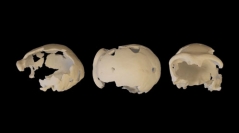

 Comptes Rendus Palevol
9 (6-7) - Pages 265-275
Comptes Rendus Palevol
9 (6-7) - Pages 265-275The limited number of unearthed fossils and their accessibility are factors that hinder paleoanthropological studies. Original remains, but also osteological collections of extant specimens, have to be curated in optimal and adapted environments, and direct manipulation needs to be limited in order to preserve this irreplaceable patrimony. Imaging methodologies have recently provided ways for innovative advances in the preservation of these collections, as well as offering new perspectives to museographic displays and original scientific studies. Here, we describe recent examples of developments obtained from imaging methodologies and discuss methodological and ethical implications of these new “virtual” collections. Undeniably, “virtual anthropology” is an additional tool in our large set of analytical possibilities and for curators, with its specific constraints related to the particular nature of the analysed material. Finally, we suggest some possible guidelines for the optimisation of the preservation, management and development of collections while preserving their scientific exploitation.
Methods, Interdisciplinarity, Collaborations, Internal anatomy, Fossils, Cultural heritage, Digitisation